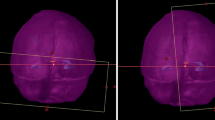Abstract
Objective
Hippocampus avoidance whole brain radiotherapy (HA-WBRT) has been shown to reduce the risk of neurocognitive dysfunction. This type of treatment has the potential of insurance company payment denial due to increased cost of intensity-modulated radiotherapy (IMRT), while the accepted modality for WBRT is three-dimensional conformal radiotherapy (3DCRT). The purpose of this study is to assess 3DCRT HA-WBRT treatment plans using multi-criteria optimization (MCO) to meet RTOG 0933 criteria.
Methods
Ten patients with brain metastases were selected, and HA-WBRT treatment plans with MCO 3DCRT technique (MCO-3D) were generated. MCO-3D plans were compared with plans using MCO IMRT techniques (MCO-IMRT). Evaluation parameters included D 98 % and D 2 % of PTV, dose homogeneity index, and D max and D 100 % of the hippocampi.
Results
For MCO-IMRT plans, PTV D 2 % and hippocampi D max and D 100 % met RTOG 0933 objectives in all ten patients (PTV D 2 % < 37.5Gy; hippocampi D max < 16Gy and D 100 % < 9 Gy). One patient met the RTOG 0933 PTV D 98 % objective (PTV D 98 % > 25Gy) and 9/10 patients met acceptable variation (PTV D 98 % < 25 Gy). For MCO-3D plans, PTV D 2 % met RTOG033 objective for all patients: 1/10 patients for PTV D 98 %, 6/10 patients for hippocampi D max, and 7/10 patients for hippocampi D 100 % met RTOG 0933 objective. All the other patients met the RTOG 0933 acceptable variation requirement (PTV D 98 % < 25 Gy; Hippocampi D max < 17Gy and D 100 % < 10 Gy).
Conclusion
All dosimetric parameters of MCO-3D plans met the criteria of at least acceptable variation per RTOG 0933. The statistic comparison results showed that there were some minor statistical differences between MCO-IMRT and MCO-3D; however, the biological difference was not of clinical importance. This may be helpful in cases where there is denial of patient’s medical insurance coverage due to the use of IMRT for HA-WBRT.



Similar content being viewed by others
References
Roman DD, Sperduto PW (1995) Neuropsychological effects of cranial radiation: current knowledge and future directions. Int J Radiat Oncol Biol Phys 31(4):983–998. doi:10.1016/0360-3016(94)00550-8
Monje ML, Mizumatsu S, Fike JR, Palmer TD (2002) Irradiation induces neural precursor-cell dysfunction. Nat Med 8(9):955–962. doi:10.1038/nm749
Mehta M.P., Andrew K, Gondi V, Tome W, Corn B, Rowley H, Caine C, Shook S. et. al (2011) A phase II trial of hippocampal avoidance during whole brain radiotherapy for brain metastases. Radiation Therapy Oncology Group, RTOG 0933 Protocol. https://www.rtog.org/ClinicalTrials/ProtocolTable/StudyDetails.aspx?study=0933.
Gondi V, Pugh SL, Tome WA, Caine C, Corn B, Kanner A, Rowley H, Kundapur V, DeNittis A, Greenspoon JN, Konski AA, Bauman GS, Shah S, Shi W, Wendland M, Kachnic L, Mehta MP (2014) Preservation of memory with conformal avoidance of the hippocampal neural stem-cell compartment during whole-brain radiotherapy for brain metastases (RTOG 0933): a phase II multi-institutional trial. J Clin Oncol Off J Am Soc Clin Oncol 32(34):3810–3816. doi:10.1200/jco.2014.57.2909
Andreas JJM, Kundapur V (2015) Hippocampus avoidance whole-brain radiation therapy: a practical intensity-modulated radiation therapy planning and delivery approach to RTOG 0933. J Med Imaging Rad Sci 46(1):78–84. doi:10.1016/j.jmir.2014.09.009
Wang BH, Hua W, Gu X, Wang XL, Li J, Liu LQ, Huang YX (2015) Dosimetric study of different radiotherapy planning approaches for hippocampal avoidance whole-brain radiation therapy (HA-WBRT) based on fused CT and MRI imaging. Australasian physical & engineering sciences in medicine / supported by the Australasian College of Physical Scientists in Medicine and the Australasian Association of Physical Sciences in Medicine. doi:10.1007/s13246-015-0397-7
Slade A, Stanic S The impact of RTOG 0614 and RTOG 0933 in routine clinical practice: the U.S. survey of utilization of memantine and IMRT planning for hippocampus sparing in patients receiving whole-brain radiation therapy for brain metastases. Int J Radiat Oncol Biol Phys 90(5):S36–S37. doi:10.1016/j.ijrobp.2014.08.214
Bokrantz R, Miettinen K (2015) Projections onto the Pareto surface in multicriteria radiation therapy optimization. Med Phys 42(10):5862–5870. doi:10.1118/1.4930252
Craft D, Richter C (2013) Deliverable navigation for multicriteria step and shoot IMRT treatment planning. Phys Med Biol 58(1):87–103. doi:10.1088/0031-9155/58/1/87
Craft DL, Hong TS, Shih HA, Bortfeld TR (2012) ) Improved planning time and plan quality through multicriteria optimization for intensity-modulated radiotherapy. Int J Radiat Oncol Biol Phys 82(1):e83–e90. doi:10.1016/j.ijrobp.2010.12.007
Khan F, Craft D (2015) Three-dimensional conformal planning with low-segment multicriteria intensity modulated radiation therapy optimization. Pract Rad Oncol 5(2):e103–e111. doi:10.1016/j.prro.2014.07.001
Gay HA, Niemierko A (2007) A free program for calculating EUD-based NTCP and TCP in external beam radiotherapy. Phys Med: PM: Int J Devoted Appl Phys Med Biol: Off J Italian Assoc Biomed Phys (AIFB) 23(3–4):115–125. doi:10.1016/j.ejmp.2007.07.001
Novitas Solutions. http://www.novitas-solutions.com. Accessed Jan 26 2016
Acknowledgments
The authors would like to acknowledge the assistance from Hancock, Carolyn, CMD, in proof-reading the manuscript and giving valuable feedback.
Author information
Authors and Affiliations
Corresponding author
Ethics declarations
Funding
The authors Dr. Xin Zhang, Dr. Jose Penagaricano, Dr. Narayanasamy Ganesh, Dr. Robert J. Griffin, Dr. Sanjay Maraboyina, Dr. Nava Paudel, Dr. Peter Corry, and Dr. Steven Morrill all attest that no funding sources are associated with this article.
Conflict of interest
The authors Dr. Xin Zhang, Dr. Jose Penagaricano, Dr. Narayanasamy Ganesh, Dr. Robert J. Griffin, Dr. Sanjay Maraboyina, Dr. Nava Paudel, Dr. Peter Corry, and Dr. Steven Morrill do not have any conflict of interest or financial disclosures relating to this work.
Ethical approval
The authors Dr. Xin Zhang, Dr. Jose Penagaricano, Dr. Narayanasamy Ganesh, Dr. Robert J. Griffin, Dr. Sanjay Maraboyina, Dr. Nava Paudel, Dr. Peter Corry, and Dr. Steven Morrill all attest that this article does not contain any studies with human participants or animals performed by any of the authors.
Informed consent
For this type of study, formal consent is not required.
Rights and permissions
About this article
Cite this article
Zhang, X., Penagaricano, J., Ganesh, N. et al. Three-dimensional conformal planning using low-segment multi-criteria optimization for hippocampal avoidance whole brain radiotherapy. J Radiat Oncol 5, 249–255 (2016). https://doi.org/10.1007/s13566-016-0263-6
Received:
Accepted:
Published:
Issue Date:
DOI: https://doi.org/10.1007/s13566-016-0263-6




